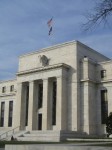Is The Fed Responsible for Higher Oil Prices?
 Photo: tiseb
Photo: tisebVincent R. Reinhart thinks so. Reinhart, an economist at the American Enterprise Institute and a former director of the Federal Reserve Board’s Division of Monetary Affairs, argues that the Fed’s quantitative easing program has raised the price of oil for American consumers:
Since the Fed firmly signaled in August its intent to launch the latest round of QE, oil prices have risen from $76 to around $100 per barrel.
Why does the Fed’s balance sheet matter for oil prices? The producers of oil as well as other commodities typically sell their output in a worldwide market priced in U.S. dollars. Thus, they care about the current and expected future purchasing power of the dollar and how that will translate into goods and services back home. But QE has been associated with higher inflation and dollar depreciation, which combines to erode the purchasing power of the foreign producers of commodities. Thus, some of the rise in the nominal price of oil has been to catch up with that erosion.
Reinhart argues that the Fed’s expansion of the money supply, coupled with low interest rates, has pushed investors toward riskier investments.
The commodity market has been one outlet for that reinvigorated search for yield. Investment flows into commodity-related vehicles has stepped up noticeably. This has been reinforced by the Fed’s policy of keeping short-term nominal interest rates near zero, which keeps it cheap to do some of that trading on borrowed funds. Such speculation neither produces nor consumes the commodity, so it should have no long-lasting effect on prices. However, over short periods, it can fuel spasms of enthusiasm or angst that trigger wide swings in prices. Oil markets experienced just that about two-weeks ago when futures prices posted their biggest one-day drop.

Comments